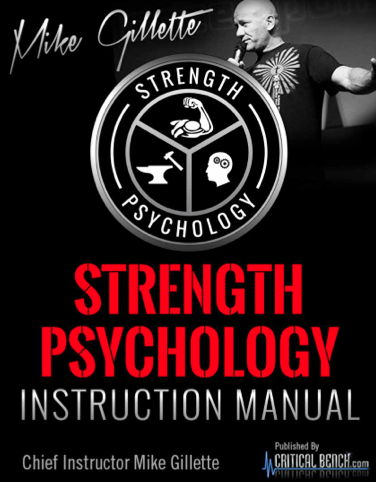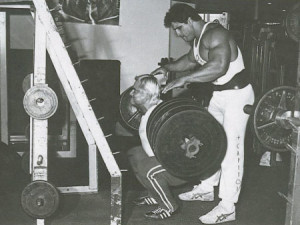I’ve had the opportunity to look over a new program called The Psychology of Strength.
Mike Gillette
 Let me start by telling you a little about he author. Gillette is a former Army paratrooper, SWAT commander, Homeland Security consultant, and armed forces tactical trainer. He is currently an executive bodyguard, performing strongman and martial arts expert (the bar you see in the picture was bent with his bare hands). He holds the world’s record for the most steel-tipped arrows broken simultaneously with his neck. He’s also the creator of the Savage Strength Training System, a popular program on this blog. Needless to say, he knows a thing or two about developing both physical and mental strength.
Let me start by telling you a little about he author. Gillette is a former Army paratrooper, SWAT commander, Homeland Security consultant, and armed forces tactical trainer. He is currently an executive bodyguard, performing strongman and martial arts expert (the bar you see in the picture was bent with his bare hands). He holds the world’s record for the most steel-tipped arrows broken simultaneously with his neck. He’s also the creator of the Savage Strength Training System, a popular program on this blog. Needless to say, he knows a thing or two about developing both physical and mental strength.
Program Components
Now let’s talk about what you get when you order the this program:
 Strength Psychology Instruction Manual: This document begins with a summary of Gillette’s fascinating life story. He was raised in a very dysfunctional environment that left him afraid and suicidal (literally) by the time he was 18. But he made the decision to turn his life around and discover his purpose. The author goes on to explain the mindset of mental Toughness he was able to develop and gives specific steps on how you can do the same.
Strength Psychology Instruction Manual: This document begins with a summary of Gillette’s fascinating life story. He was raised in a very dysfunctional environment that left him afraid and suicidal (literally) by the time he was 18. But he made the decision to turn his life around and discover his purpose. The author goes on to explain the mindset of mental Toughness he was able to develop and gives specific steps on how you can do the same.
The Videos: This program also includes videos where you can hear Mike Explain the concepts in more detail. The videos are the most important component of The Psychology of Strength program.
Video 1: Introduction–Mike begins this video by describing people who are not mentally tough–people who “just get by.” These kinds of people, he argues, have a tendency to settle for less in life. This can be changed if you develop mental toughness and take control of your mind, which will enable you to pursue the life you want. He explains how this happened in his life and how he wants to help it happen for you. This program, he explains, combines things he has learned from the various phases in his life (military, law enforcement, etc.).
Video 2: Personal Story of Strength–As I’ve mentioned, Gillette had a rough upbringing. Hearing him share it personally is very powerful: “My story is one of weakness transformed into strength and second chances.”
Video 3: Mental Toughness (Part 1)–The primary concept in this video is the mindset of mental toughness. Mike talks a great deal about the connection between the body and the mind. Physical talent, for example, is not maximized until one develops the mental focus need to perform optimally. He also discusses how negative emotions can affect everything we do. This video includes some specific strategies to change negative emotions.
Video 4: Mental Toughness (Part 2)–-This video focuses on fear–learning what it is so you can begin to overcome it. Mike starts off by sharing a personal testimony of how fear used to control his life. Fear management training is a concept you’ll be introduced to–not banishing fear (which is impossible and even inadvisable), but learning to face it. “What I want you to be able to do is recognize fear and do what you want to anyway,” he says.
Video 5: Mental Toughness (Part 3)–Mike talks about overcoming fear in this video. Once again he shares a personal story (this one from his days as a police officer) illustrating our tendency to “freeze” when we are afraid. He takes his life-or-death experience and explains how the same principles apply to almost any fear-based experience. Mike then gives some practical steps that will help you confront and manage your fear.
Video 6: Life by Design (Part 1)–This video teaches you how to make effective plans for your life. People often fail, Mike argues, because they don’t plan well. Example: someone may say he wants to lose weight. This is an admirable goal, but it just isn’t specific enough to really mean anything. One component of proper planning is a specific, measurable goal. This video really focuses on how to make challenging yet attainable goals and reach them.
Video 7: Life by Design (Part 2)–Mike shows you how to set long-term goals for five different areas of your life (physical, financial, etc.).
Video 8: Mind Strengthening Skills–This final video offers several mental exercises you can practice. Mike encourages you to try all these skills/techniques so you can gain better control of your thoughts and improved awareness of your body (breathing, etc.). Practicing these techniques can help you become physically stronger as you improve over time.
Review:
Sometimes we think mentally strong people were just born that way or grew up with every possible advantage. This may be true in some cases, but it definitely wasn’t in Mike’s. Mental strength is something anyone can develop if he/she will simply commit to new ways of thinking.
Most of the programs I review are about diet and training–physical aspects of self-improvement. The Psychology of Strength is unique in that it deals almost exclusively with the mental aspect of improving your life. I think it is worth your time/money.
I think this program would be good for the following:
*Athletes/trainees that want to overcome psychological barriers and further develop the mental aspect of their skill/game.
*People who want to overcome fear or lack of confidence.
*People who want to live more intentionally.
*Coaches and/or motivational speakers who want to add to their personal development library.
I think The Psychology of Strength would be a worthwhile investment if this describes you (or if what I’ve shared in this review/summary appeals to you). The digital version is $49 and the “hard copy” version is $99. This is relatively inexpensive when compared to what it would cost to go to a seminar of this length and quality.
JUST CLICK HERE IF YOU WOULD LIKE TO ORDER THIS PROGRAM OR LEARN MORE.
Note: You may see a video called The End of the American Male at the bottom of the program page. I personally do not endorse (or use) any “testosterone booster” supplements. My review only covers the program I have described, not any other products.
Alternative Products: As I’ve mentioned, Mike Gillette has a program called the Savage Strength Training System. Feel free to check it out if you want to learn more about his physical approach to strength training.
